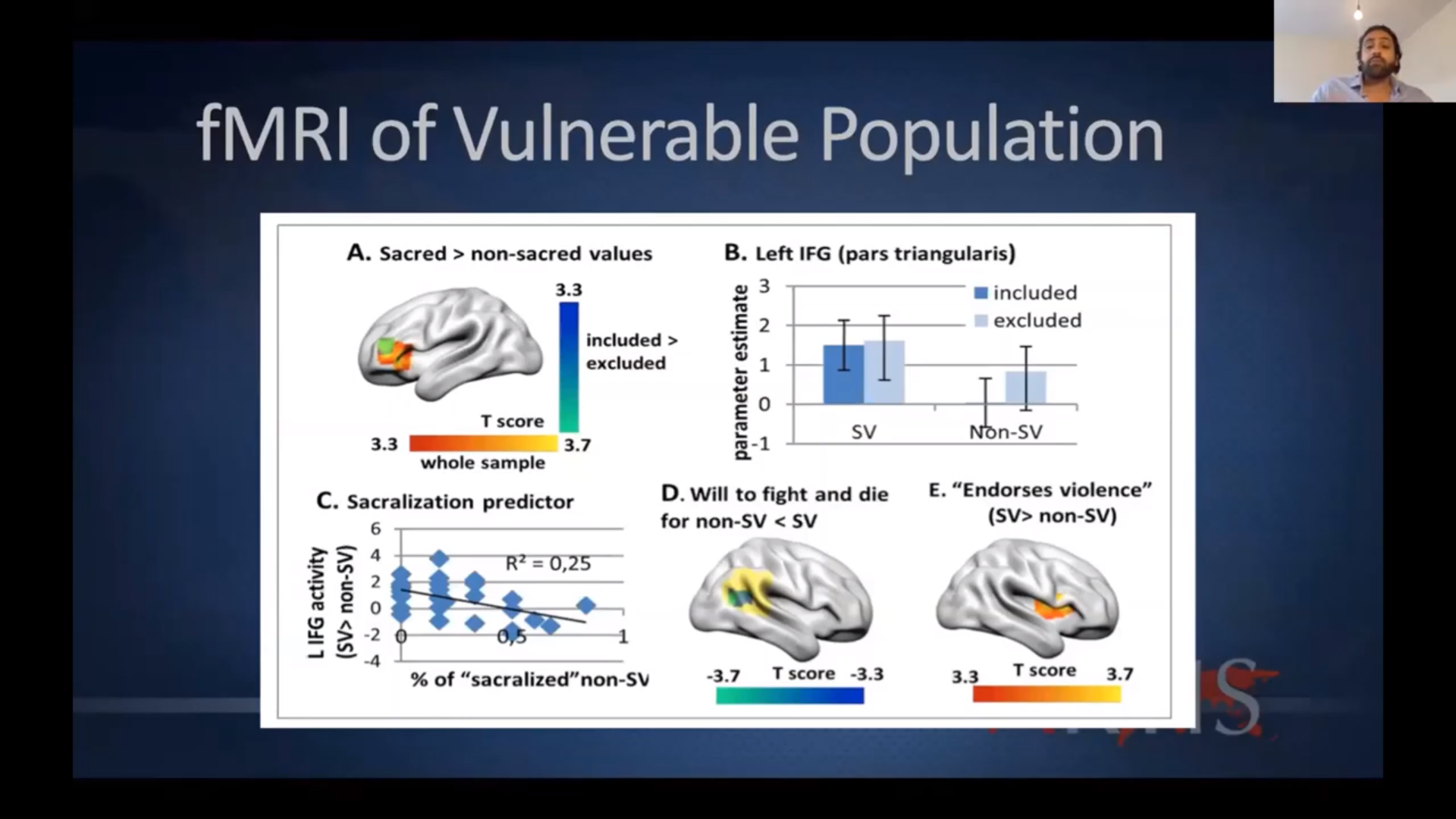By:Cameron Cassar
“In societies around the world where the social fabric is torn, perhaps a better understanding of brain science can help guide efforts to bridge societal divides,” said MHCR Senior Research Professor and Think Peace Podcast host Colette Rausch. Her words helped set the stage for the last event of the MHCR Spring Webinar Series “Knowing Us, Knowing Them: Applying the Neuroscience of Group Dynamics to Reconciliation and Peacebuilding” which was organized by MHCR in collaboration with Beyond Conflict on May 19th.
Screenshot of our panel of neuroscience researchers and peacebuilding practitioners as well as some of our MHCR staff.
The goal of this event was to explore the intersection of neuroscience and peacebuilding as well as discuss the roles of threat and empathy in understanding some of the breakdowns between individuals and communities. The panelists included renowned neuroscience researchers and peacebuilding practitioners as they engaged in dialogue regarding this nexus. These panelists included: Rachel Brown (Founder and Executive Director of Over Zero), Dr. Nafees Hamid (Research Fellow at Artis International), and Dr. Lasana Harris ( Associate Professor of Experimental Psychology at University College London). Mike Niconchuk (Program Director of Trauma and Violent Conflict at Beyond Conflict) served as the moderator for an insightful discussion that touched upon human social cognition, the science of dehumanization and intergroup violence as well as how this science and research is put into practice.
Screenshot of Mike’s presentation of the neurobiology of the brain
Mike Niconchuk, an applied neuroscientist researcher and practitioner who focuses his research on trauma recovery in conflict-affected populations and the relationship between trauma and intergroup violence opened up the discussion by giving us a presentation on human social cognition as well as the neurobiology of the brain. Mike broke down how our brains perceive and process our surroundings and how these perceptions affect the brain and body’s response to threats. “We have brains and bodies that are first and foremost very unconscious, very sensitive to threats in our environment and these same threats coordinate with all of our physiological responses that enable us to be predisposed to in and out-group thinking.”
Screenshot of Dr. Lasana’s presentation on how the brain perceives race
Lasana Harris, a social neuroscientist who centers his research around the science of dehumanization and the formation of biases, expanded upon Mike’s presentation. Lasana explained what brain processes are responsible for the development of biases and empathy. He explained how implicit bias plays a major role in group relations and how this stems from someone’s upbringing as well as their experiences with the outgroup. “This has a lot to do with the cultural narratives, the stories that are being told in societies, in all cultural contexts that really serve to shape the ingroups and outgroups thinking.” He emphasized the importance of the amygdala “the burglar alarm” of the brain which fires up when we feel threatened, as well as the neocortex which is responsible for sensory perception and serves as the control center of consciousness for humans.
Screenshot of Nafees Hamid breaking down how we choose to protect our sacred values.
Nafees Hamid, a research fellow who focuses his research on the psychology of radicalization and social fragmentation in Western countries, talked about the findings of his research examining those who commit acts of terror. Nafees broke down the significance of sacred values and discussed how different groups have different sacred values. “Jihadists may say they believe in a strict sharia, an Islamic caliphate while white nationalists may say they believe in an ethno state and many mainstream people may believe in freedom of speech and free and fair elections.” Nafees broke down how these different groups will go to different lengths to protect their sacred values. He explained how some members of certain groups choose to abstain from violence and find peaceful ways to go about protecting their values while other groups choose to embrace violence and martyrdom in the name of their struggle.
Screenshot of Rachel Brown explaining the meaning behind the creation of alternate identities
Rachel Brown, a globally recognized peacebuilder and the founder and director of Over Zero, whose area of expertise centers around confronting hateful and dangerous rhetoric to reduce violent conflict especially in the media. Rachel gave some examples from her research and work where “alternative identities'' were used in Bosnia, Kenya, and Rwanda. She believes that alternative identities are powerful because they give people a sense of belonging outside of these rigid conflict identities, create new within-group norms, and provide opportunities for collaboration as well. Rachel also went on to break down how relations between different groups can be affected by misinformation and disinformation. “ Misinformation and disinformation have always been a part of conflict...you need lies to dehumanize a group, you need lies to portray an entire group of people as so threatening that there’s no option other than violence and misinformation is often used to organize and mobilize.” These are tools of escalation and division that use rumors and propaganda to portray the outgroup as a threat and the ingroup as your protection which is why they play such a crucial role in exacerbating conflicts.
The event closed with a discussion among all the panelists as they answered more pointed questions about their work as well as engaged in discourse regarding the future of neuroscience-aware peacebuilding practices. Events such as “Knowing Us, Knowing Them” are essential to the field of peacebuilding because a deeper understanding of the circuitry of the brain and the role that it plays in shaping our perceptions and biases is needed in order to effectively bridge divisions within our society.
You can watch the full event here.
For more MHCR resources regarding neuroscience and peacebuilding, you can check out the Think Peace Podcast: Where Peace Crosses the Mind or our newest publication NeuroPeace.





